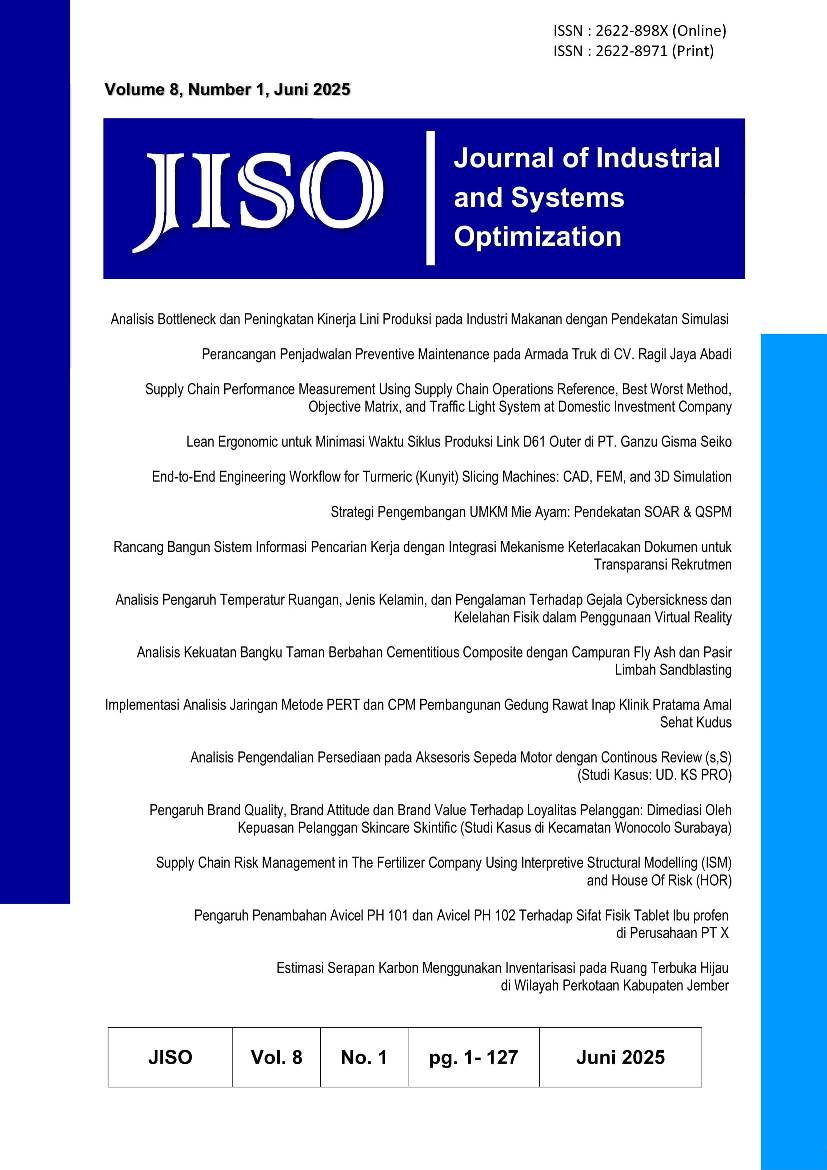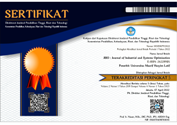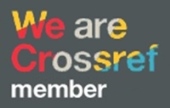SUPPLY CHAIN RISK MANAGEMENT IN THE FERTILIZER COMPANY USING INTERPRETIVE STRUCTURAL MODELLING (ISM) AND HOUSE OF RISK (HOR)
DOI:
https://doi.org/10.51804/jiso.v8i1.104-111Keywords:
supply chain, risk management, house of risk, interpretive structural modelingAbstract
ABSTRAK
Pertanian memegang peran penting di Indonesia, khususnya dalam pembangunan ekonomi. Untuk memastikan keberlanjutan sektor pertanian di Indonesia, potensi risiko terhadap keseluruhan proses produksi dan distribusi harus dikelola dengan tepat. Pupuk merupakan salah satu komponen kunci yang sangat dibutuhkan dalam kegiatan agraria. Namun, risiko dalam rantai pasok pupuk dapat mempengaruhi ketersediaan produk dan perlu dimitigasi untuk memastikan aliran produk yang efektif dan efisien. Penelitian ini bertujuan untuk mengidentifikasi risiko dalam rantai pasok pupuk dan keterkaitan antara risiko tersebut. Dengan menggunakan studi kasus PT X, salah satu perusahaan pupuk di Indonesia, penelitian ini mengevaluasi kejadian dan penyebab risiko tersebut, mengidentifikasi area prioritas untuk manajemen risiko, dan memberikan rekomendasi untuk tindakan mitigasi risiko dalam proses bisnis PT X. Model Supply Chain Operations Reference (SCOR) digunakan untuk mengidentifikasi proses bisnis dalam rantai pasokan PT X. Dari proses bisnis, 46 peristiwa risiko diidentifikasi. Setelah itu, Interpretive Structural Modeling (ISM) dilakukan untuk menilai keterkaitan antara elemen risiko dan menentukan elemen risiko prioritas di antara peristiwa risiko. Proses ini menghasilkan 21 peristiwa risiko prioritas utama. Peristiwa risiko ini kemudian diprioritaskan menggunakan House of Risk (HOR) Tahap I, yang menghasilkan tiga agen risiko prioritas. Langkah terakhir adalah HOR Tahap II, di mana enam tindakan preventif dirumuskan sebagai strategi mitigasi risiko.
ABSTRACT
Agriculture holds a critical role in Indonesia, particularly in economic development. To ensure the sustainability of the agricultural sector in Indonesia, potential risks to the overall production and distribution processes must be appropriately managed. Fertilizer is one key component that is fundamentally required in agrarian activities. However, risks in the fertilizer supply chain could affect the availability of the product and need to be mitigated to ensure the effective and efficient flow of the product. This research aims to identify the risks in the fertilizer supply chain and the interrelationships between these risks. Using a case study of PT X, one of the fertilizer companies in Indonesia, this research evaluates the occurrences and causes of these risks, identifies priority areas for risk management, and provides recommendations for risk mitigation actions in PT X's business processes. The Supply Chain Operations Reference (SCOR) model is used to identify the business processes in PT X's supply chain. From the business process, 46 risk events are identified. Afterward, Interpretive Structural Modeling (ISM) is performed to assess the interrelationships between the risk elements and determine the priority risk elements among the risk events. This results in 21 key priority risk events. These risk events are then prioritized using House of Risk (HOR) Phase I, which results in three priority risk agents. The final step is HOR Phase II, where six preventive actions are formulated as risk mitigation strategies.
References
Agung S, C.W., Kusrini, N. and Gafur, S. (2018) ‘Analisis Faktor yang Mempengaruhi Pasokan Minyak Goreng Bekas Rumah Makan Menggunakan ISM dan MICMAC’, Journal Social Economic of Agriculture, 7(2), pp. 1–10.
Altieri, M.A. and Nicholls, C.I. (2020) ‘Agroecology and the emergence of a post COVID-19 agriculture’, Agriculture and Human Values, 37(3), pp. 525–526. Available at: https://doi.org/10.1007/s10460-020-10043-7.
Babu, H. and Yadav, S. (2023) ‘A supply chain risk assessment index for small and medium enterprises in post COVID-19 era’, Supply Chain Analytics, 3(June), p. 100023. Available at: https://doi.org/10.1016/j.sca.2023.100023.
Behzadi, G. et al. (2018) ‘Agribusiness supply chain risk management: A review of quantitative decision models’, Omega (United Kingdom), 79, pp. 21–42. Available at: https://doi.org/10.1016/j.omega.2017.07.005.
Dehdar, E., Azizi, A. and Aghabeigi, S. (2019) ‘Supply Chain Risk Mitigation Strategies in Automotive Industry: A Review’, IEEE International Conference on Industrial Engineering and Engineering Management, 2019-Decem, pp. 84–88. Available at: https://doi.org/10.1109/IEEM.2018.8607626.
Funk, C.C. and Brown, M.E. (2009) ‘Declining global per capita agricultural production and warming oceans threaten food security’, Food Security, 1(3), pp. 271–289. Available at: https://doi.org/10.1007/s12571-009-0026-y.
Ho, W. et al. (2015) ‘Supply chain risk management: A literature review’, International Journal of Production Research, 53(16), pp. 5031–5069. Available at: https://doi.org/10.1080/00207543.2015.1030467.
Jüttner, U., Peck, H. and Christopher, M. (2003) ‘Supply chain risk management: outlining an agenda for future research’, International Journal of Logistics Research and Applications, 6(4). Available at: https://doi.org/10.1080/13675560310001627016.
Natalia, C. et al. (2020) ‘Interpretive Structural Modeling and House of Risk Implementation for Risk Association Analysis and Determination of Risk Mitigation Strategy’, Jurnal Ilmiah Teknik Industri, 19(1). Available at: https://doi.org/10.23917/jiti.v19i1.9014.
Nguyen, T.L.T. et al. (2018) ‘Managing risks in the fisheries supply chain using House of Risk Framework (HOR) and Interpretive Structural Modeling (ISM)’, IOP Conference Series: Materials Science and Engineering, 337(1). Available at: https://doi.org/10.1088/1757-899X/337/1/012030.
Pujawan, I.N. and Geraldin, L.H. (2009) ‘House of risk: A model for proactive supply chain risk management’, Business Process Management Journal, 15(6). Available at: https://doi.org/10.1108/14637150911003801.
Rozaki, Z. (2020) ‘COVID-19, Agriculture, and Food Security in Indonesia’, Reviews in Agricultural Science, pp. 243–260.
Tang, C. and Tomlin, B. (2008) ‘The power of flexibility for mitigating supply chain risks’, International Journal of Production Economics, 116(1), pp. 12–27. Available at: https://doi.org/10.1016/j.ijpe.2008.07.008.
Vafadarnikjoo, A. et al. (2023) ‘A novel grey multi-objective binary linear programming model for risk assessment in supply chain management’, Supply Chain Analytics, 2(March), p. 100012. Available at: https://doi.org/10.1016/j.sca.2023.100012.
Downloads
Published
Issue
Section
License
Copyright (c) 2025 JISO : Journal of Industrial and Systems Optimization

This work is licensed under a Creative Commons Attribution-ShareAlike 4.0 International License.
With the receipt of the article by JISO Editorial Board and the decision to be published, the copyright regarding the article will be transferred to JISO. The copyright transfer form can be downloaded here.
JISO has the right to multiply and distribute the article and every author is not allowed to publish the same article that was published in this journal.
JISO is licensed under a Creative Commons Attribution-ShareAlike 4.0 International License.
Under the following terms:
Attribution — You must give appropriate credit, provide a link to the license, and indicate if changes were made. You may do so in any reasonable manner, but not in any way that suggests the licensor endorses you or your use.
ShareAlike — If you remix, transform, or build upon the material, you must distribute your contributions under the same license as the original.














